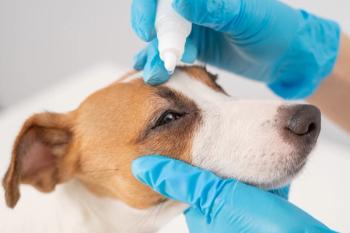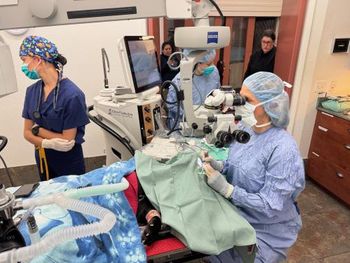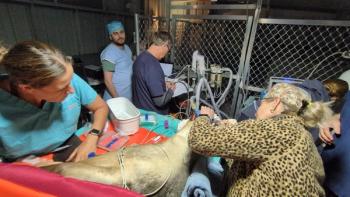
Common ocular disorders and treatments for the small animal practitioner (Proceedings)
Indications of a full thickness eyelid wedge resection include mass, tumor and entropion/ectropion.
Full Thickness Eyelid Wedge Resection
-indications: mass, tumor and entropion/ectropion
-up to 1/3 of eyelid margin can be removed safely and skin reapposed
-use 2 layer closure (conjunctiva-6-0 absorbable; skin-4-0 or 5-0 nylon)
-initial skin suture should be at skin margin
Corneal Grid Keratotomy
-indications: indolent corneal ulceration only
-initially need to debride which can be done by #15 blade and local anesthesia only
-I use a 21 gauge needle (tip does not need to be bent)
-grid approximately 1mm into normal epithelium/stroma
-consider concurrent use of a collagen shield
-triple antibiotic BID (gentocin may be toxic to reepithelialization), ± atropine
Prolapsed Gland of Third Eyelid
-always attempt to replace a viable gland
-examine for scrolled cartilage and excise if present
-a number of tacking procedures exist but the pocket technique is recommended
-2 parallel incisions are made in the bulbar conjunctiva above and below the gland
-outside edges of each incision are apposed with a continuous pattern of 7-0 vicryl-burying the knot
-postop triple antibiotic HC ointment recommended
-generally will tack down up to 2 times before considering excision
Eyelid Tacking
-most commonly necessary and performed in Shar-pei and Chow Chow puppies with neonatal entropion
-used in adults to break spastic entropion
-usually no anesthesia necessary (young puppies); sedation may be required in select patients
-4-0 – 5-0 nylon used in vertical or horizontal pattern (I prefer a horizontal approach but published illustrations usually show a vertical one)
-staple blepharoplasty quick and simple alternative to sutures
-attempt to leave sutures/staples in place for up to 3 weeks
-likely that permanent corrective surgery will be necessary—usually performed at 4 – 6 months of age (sooner if corneal ulceration is a problem)
Vitreous Centesis
-indications: a safe and effective procedure for injection and or aspiration in visual or nonvisual eyes ie. injection for ciliary body ablation or aspirate for cytology/C & S-bacterial or fungal
-21 to 23 gauge needle
-needle is directed obliquely through the ora serrata (approx.. 7 – 8 mm posterior to limbus) and into the vitreous to avoid the lens
Temporary Tarsorrhaphy
-indications: stromal ulceration where optimal corneal surgery (i.e. conjunctival graft) is not possible; providesprotection following corneal graft
-techniques
-suture: 4-0 or 5-0 nylon; location
-tissue adhesive: VetBond® (n-butyl cyanoacrylate)
Newsletter
From exam room tips to practice management insights, get trusted veterinary news delivered straight to your inbox—subscribe to dvm360.




